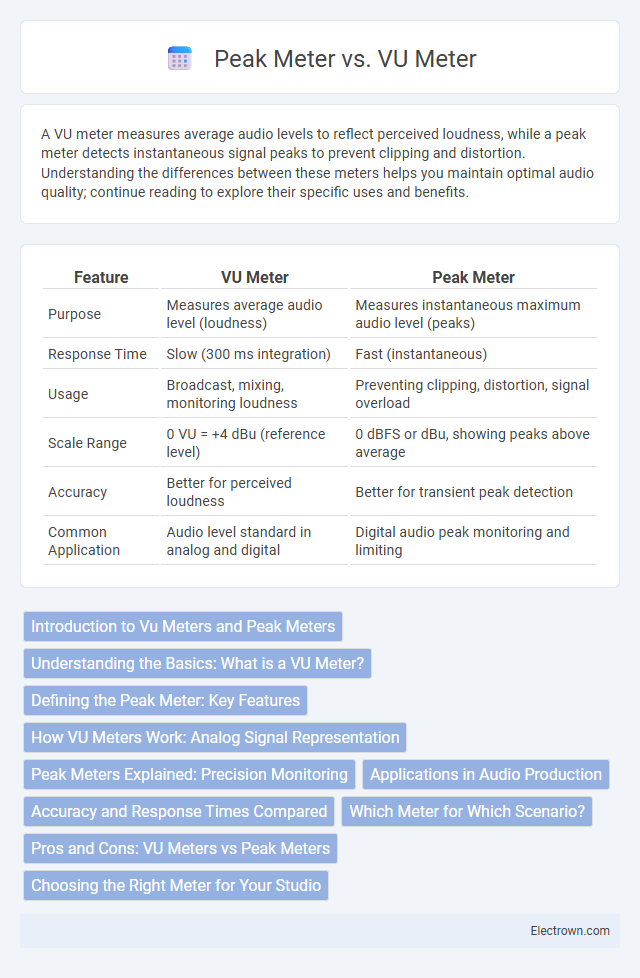A VU meter measures average audio levels to reflect perceived loudness, while a peak meter detects instantaneous signal peaks to prevent clipping and distortion. Understanding the differences between these meters helps you maintain optimal audio quality; continue reading to explore their specific uses and benefits.
Table of Comparison
| Feature | VU Meter | Peak Meter |
|---|---|---|
| Purpose | Measures average audio level (loudness) | Measures instantaneous maximum audio level (peaks) |
| Response Time | Slow (300 ms integration) | Fast (instantaneous) |
| Usage | Broadcast, mixing, monitoring loudness | Preventing clipping, distortion, signal overload |
| Scale Range | 0 VU = +4 dBu (reference level) | 0 dBFS or dBu, showing peaks above average |
| Accuracy | Better for perceived loudness | Better for transient peak detection |
| Common Application | Audio level standard in analog and digital | Digital audio peak monitoring and limiting |
Introduction to Vu Meters and Peak Meters
VU meters and peak meters serve distinct functions in audio level monitoring, with VU meters measuring average loudness over time, reflecting perceived sound levels. Peak meters detect instantaneous signal peaks, preventing distortion by indicating the highest audio levels reached. Understanding the operational differences aids in accurate audio mixing and mastering for optimal sound quality.
Understanding the Basics: What is a VU Meter?
A VU meter (Volume Unit meter) measures the average audio signal level, reflecting perceived loudness by simulating human ear sensitivity. Unlike peak meters that capture instantaneous signal peaks to prevent clipping, VU meters provide a smoother, more consistent indication of audio volume over time. Your audio mixing benefits from understanding VU meters to achieve balanced, natural sound without the sharp fluctuations of peak level readings.
Defining the Peak Meter: Key Features
The peak meter measures the instantaneous maximum level of an audio signal, ensuring no distortion or clipping occurs during recording or mixing. It provides precise, real-time readings of transient peaks, making it essential for monitoring signal peaks in dynamic audio content. Unlike VU meters, peak meters respond quickly to sudden level changes, capturing the true signal peaks necessary for digital audio environments.
How VU Meters Work: Analog Signal Representation
VU meters measure the average level of an audio signal using a moving-coil meter calibrated to reflect perceived loudness, displaying smooth, steady readings. Peak meters detect the maximum instantaneous level of a signal, often using fast-responding LEDs, crucial for preventing clipping. Analog VU meters respond more slowly due to their electromechanical design, offering a visual representation of the signal's overall energy rather than exact peaks.
Peak Meters Explained: Precision Monitoring
Peak meters provide precise monitoring by displaying the maximum instantaneous audio level, allowing you to avoid distortion and clipping in recordings or broadcasts. Unlike VU meters, which show average levels and respond more slowly, peak meters capture rapid dynamics essential for maintaining audio fidelity. This precision is crucial for sound engineers aiming to ensure clean and accurate sound without overload.
Applications in Audio Production
Vu meters excel in measuring average audio levels, making them ideal for monitoring overall loudness during mixing and broadcasting to maintain consistent sound quality. Peak meters detect transient spikes, which helps prevent clipping and distortion by alerting you to sudden high-level signals in recording and mastering processes. Choosing between a VU meter and a peak meter depends on whether your priority is smooth loudness control or precise peak level monitoring in your audio production workflow.
Accuracy and Response Times Compared
VU meters provide an average level measurement with slower response times, typically around 300 milliseconds, which captures perceived loudness but can miss brief transients. Peak meters offer high accuracy with near-instantaneous response times, often less than 1 millisecond, accurately reflecting signal peaks for preventing clipping and distortion. Accurate metering is critical in audio production, making peak meters essential for digital environments while VU meters remain useful for assessing overall signal levels in analog contexts.
Which Meter for Which Scenario?
VU meters are ideal for measuring average audio levels, making them perfect for broadcast and live sound environments where consistent volume is crucial. Peak meters excel in detecting sudden audio spikes, ensuring your recordings avoid clipping and distortion during dynamic performances or mixing. Choose the meter that best suits your scenario to maintain optimal audio quality in your projects.
Pros and Cons: VU Meters vs Peak Meters
VU meters provide a smoother, averaged reading of audio levels, making them ideal for monitoring perceived loudness and preventing consistent distortion; however, they react slower to transient peaks. Peak meters respond instantly to rapid signal spikes, essential for avoiding clipping and ensuring headroom in digital audio, but may appear overly sensitive and less representative of perceived volume. Choosing between these meters depends on Your specific audio monitoring needs, balancing the clarity of dynamic peaks with the accuracy of loudness perception.
Choosing the Right Meter for Your Studio
Choosing the right meter for your studio depends on accuracy and application; VU meters measure average audio levels and are ideal for monitoring perceived loudness in mixing, while peak meters detect transient spikes to prevent clipping and distortion during recording. Understanding that VU meters offer smoother, slower readings helps maintain consistent audio dynamics, whereas peak meters provide precise, instantaneous feedback crucial for digital audio workstations. For optimal studio performance, combining both meters ensures balanced sound quality and technical accuracy across production stages.
vu meter vs peak meter Infographic

 electrown.com
electrown.com